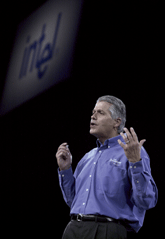For years, it was all about clock speed. A government IT shop could tell if it was on the leading edge of computer technology by the clock speed of its system processors'now measured largely in gigahertz.But times changed. With each new generation of chips, more speed didn't necessarily lead to better performance, and the heat generated by frenzied CPU clocks grew harder to manage. These days, keeping data centers cool presents an ongoing challenge, and agencies often stick with existing systems longer than usual because they don't see much return on investing in newer computers.Finally, in October, CPU leader Intel Corp. conceded that faster clocks aren't the way to go'an idea its competitors, including Advanced Micro Devices Inc. of Sunnyvale, Calif., had already embraced. Intel scrapped plans to release a 4-GHz version of its Pentium 4 processor and decided to speed development of a new generation of CPUs: dual-core processors.In the coming year, Intel and AMD will ship brand-new, high-performance processors that may actually operate more slowly than current chips. But under the hood of each processor will be the innards of two CPUs. These dual-core processors, company officials said, represent the best way to increase performance while managing not only power consumption but also cost.Agencies are asking for such capabilities in a new generation of processors, said Alfred Toussaint, Intel federal marketing manager. 'In data centers with high-performance computing clusters, agencies say they need these solutions to get better performance without burning a hole in the ground,' he said.Neither Intel nor AMD is the first chip company to come up with dual-core processors'IBM Corp. and Sun Microsystems Inc. have developed dual-core chips, although not based on the popular x86 standard. But both companies have pledged to introduce dual-core options across their entire lines'desktop, server and mobile'starting next year.In separate interviews, Frank Spindler, vice president of Intel's corporate technology group, and Fred Weber, chief technology officer of AMD, talked about their dual-core initiatives. The companies are taking slightly different approaches, but both preach similar benefits for government systems. Intel will focus initially on a dual-core version of its 64-bit Itanium processor before concentrating on desktop chips; AMD plans to roll out dual-core Opterons for servers and workstations first. Neither company has released pricing plans.Intel's Frank Spindler: A lot of times, people looked at processors and their performance by looking at how fast the frequency was. [IMGCAP(2)] We're shifting away from that as a way of enhancing performance and moving more toward multiple devices, multiple cores on any one processor to continue to drive performance. That's because there just isn't as great a return architecturally from cranking the frequency on a part as there was in the past. Going with this approach also lets us get more performance but do it in a more power-efficient and thermal-efficient way, which is real important because more people are interested in smaller, mobile types of devices.AMD's Fred Weber: The reason we'and the whole industry'are going to dual-core now is not because of some deep technological insight that wasn't there before. It's not, as people think, because power is out of control. What's really going on is, as Moore's Law jumps along, you keep adding stuff to a processor. If you look back, there was lots more stuff we wanted to add to the processor to make it better and we couldn't. There just weren't enough transistors.We've really reached the point where, if you add twice as many transistors to a processor, you only get 10 percent more performance. The best processor that we know how to make, that balances performance and area efficiency, only takes about half a reasonable die size. If your choice is to use the rest of those transistors for 10 percent more performance or put a second processor down, it's pretty obvious which choice to make.Weber: About five or six years ago when we started the Opteron design, we were looking into the future and we said 90 nanometers is where this is going to happen. The designs we're starting today are going to end up in 90 nanometers. So we designed them from the beginning for dual-core. That's why we're able to get the dual-core out so rapidly.The chip fits in the exact same socket as the single-core, and it's at the exact same power level. So if you want to take today's HP DL585, which is a four-processor server, you can substitute in dual-core for single-core. Simply change the BIOS software, nothing else has to change. The operating system doesn't have to change because the OS already understands multiple processors, and to the OS it just looks like an eight-processor machine now.Spindler: We'll have dual-core processors across all our product families'servers, desktop and mobile'in production in 2005. In the Itanium family, the project is called Montecito. We haven't gotten specific about order of introduction, but we've demonstrated Montecito publicly'it's got 1.7 billion transistors, so it's our first billion-transistor part. It's got multiple threads running on multiple cores on multiple chips in a system, so there are lots of levels of parallelism.We've demonstrated a dual-core desktop part, but we have not provided specifics. Our dual-core mobile processor is called Yonah, which is going to utilize our next generation of processor technology, which is 65 nanometers. That's more of a later '05 production period.Spindler: I wouldn't necessarily read anything into that. We agree that's an area that is already heavy-duty multiprocessor, so dual-core makes a lot of sense there. The priority for us has been desktop dual-core. We'll have Itanium pilots out there midyear to the end of the year. You'll see high-volume Itanium dual-core in '06, rolling out in '05. But the priority is on the desktop. On Xeon we've said first quarter '06. We chose to go with Itanium first and then focus on the desktopWeber: Mid-2005, we'll be launching dual-core into the server and workstation market. We'll follow up in the second half of the year with dual-core for the client. We're demonstrating our dual-core publicly now. It's basically two Opteron processors on the same die. They have separate cache controllers, which is the right place to start, although over time you'll see shared caches. It's lower risk to start with separate caches because you get less interference between programs. There's some sharing logic that lets the processors talk to each other.In 2006, you'll see more of the market going to dual-core. And in 2007, you'll see quad-core starting to become important Weber: Performance gains depend on your application and whether you're running it at the same frequency or a higher frequency. For the vast number of programs you should see performance gains in the 40 to 70 percent range. The initial most valuable place from an application point of view is going to be around transaction processing, database processing, terminal serving. We're seeing great results with SAP, Oracle databases, DB2 databases. There are some scientific applications that really need memory bandwidth, and the dual-core doesn't add memory bandwidth so you won't see as much gain.Depending what you're doing with a client, dual core can have significant value. If you're doing digital content creation, very compute-intensive stuff, big win ' .In the workstation client space, they need this desperately. On a desktop you or I would use, where you're doing PowerPoint and typing and things like that, it will be less valuable.
AMD's Fred Weber describe dual-core processors as the next natural evolutionary step for chips.
Rick Steele
Intel's Frank Spindler also describe dual-core processors as the next natural evolutionary step for chips.








